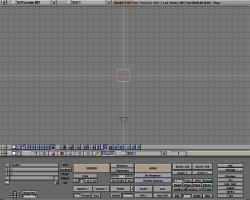3.1 Blender Viewing
Installation done? Then you're ready for take off. Start up Blender (BLENDERDIR/blender). The startup should be finished within a few seconds.
 What you see is the contents and window layout of the $home/.B.blend file.
This file is a regular blender file and is the default file that loads
automatically on startup. Every user can create its own default windows,
preset Materials, models, directories, etcetera. You can save the user
defaults at any time pressing CTRL-u.
What you see is the contents and window layout of the $home/.B.blend file.
This file is a regular blender file and is the default file that loads
automatically on startup. Every user can create its own default windows,
preset Materials, models, directories, etcetera. You can save the user
defaults at any time pressing CTRL-u.
3.1.1. Let's get used with 3D view manipulation.
The largest window is the 3D view. It contains a plane
(square), a camera and a 3D cursor.
- Click with LeftMouse in the 3D window. The 3D cursor
moves to this location. The 3D cursor is important to indicate where new
objects appear or for rotating and scaling purposes.
- Click, hold and move MiddleMouse in the 3D window.
This is the Trackball style view rotation. Try this (click-hold-move) at
different locations in the window to feel the TrackBall method.
- Try the same while holding a SHIFT key. SHIFT+MiddleMouse
is translation.
- CTRL+MiddleMouse is for zooming in and out.
The translation and zoom options are also available as
buttons in the header of each 3D window:
![]() Hold these and move the mouse.
Hold these and move the mouse.
Keyboard alternatives for these mouse commands are: (all
view related commands are located in the numerical pad).
[4] [8] [6] [2]: rotate view.
SHIFT+[4] [8] [6] [2]: translate view.
[+] [-]: zoom in and out.
3.1.2.
The standard presets TOP FRONT SIDE view are also available
via numerical pad (note the 'logical' location of the keys).
[7]: top view (+shift: under)
[1]: front view (+shift: back)
[3]: right view (+shift: left)
Which view has been selected is reminded in a (non functional)
header button. ![]()
3.1.3 The next thing to understand are the view modes.
![]()
- Orthonormal / perspective: toggle this with numpad
[5] or use the
header button.
Both view modes allow manipulation as described in the
previous section.
- Camera view: press numpad [0]. This can also be activated
with the header button.
You can get rid of this by any view command, except numpad
[+] and [-].
If you get lost or want to display everything currently
visible, press 'Home' or the header button with the little house.
If you still don't see anything, then better try to start
over: press CTRL-x. This deletes everything and reloads the default home
file.
3.1.4 Layers
![]()
Blender layers are used to organize work and control
visibility. Every Object has a layer setting, Scenes and 3D windows have
layers to detect which Objects are visible.
Currently, there are 20 layers available. Press 'm' to
move an Object to a certain layer setting. An Object can have multiple
layers, any combination is possible.
< site under construction !!!>
 getting started
getting started